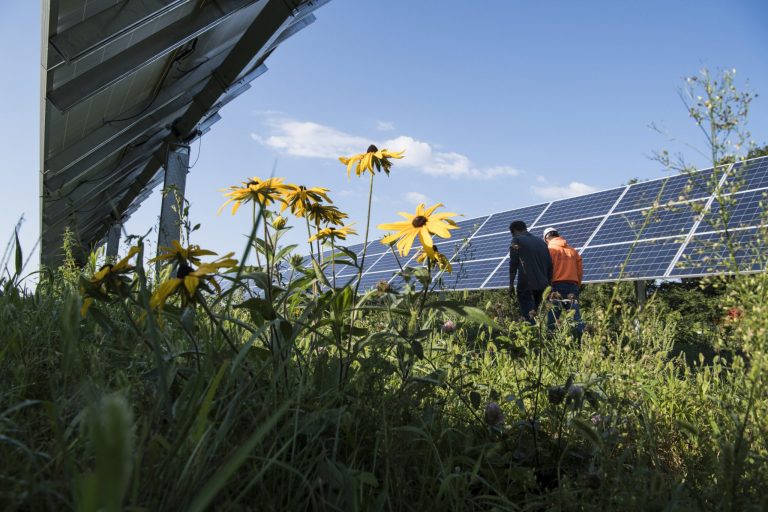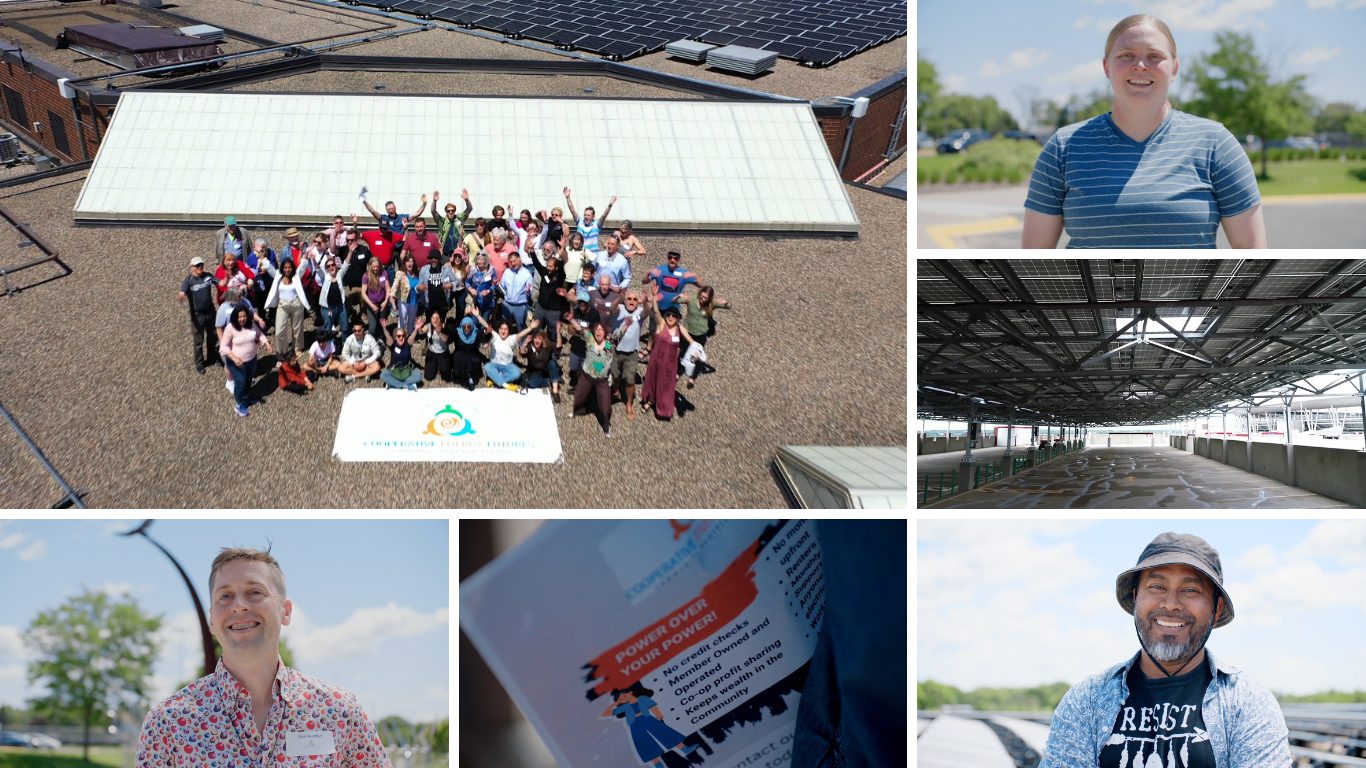
ምድብ:የውጤት ታሪክ11 ደቂቃ ተነቧል
ምድብ:የውጤት ታሪክ11 ደቂቃ ተነቧል
At the McKnight Foundation, we’re all in on our mission, using every tool in our toolbox as a philanthropic organization to bring about a more just, creative, and abundant future where all people and our planet thrive—from grantmaking to our new office, from our networks of relationships to the ways we invest our endowment.
One of our most recent investments is in a local company based in Minnesota called Cooperative Energy Futures that’s leading the country in their efforts to expand access to solar energy for all residents, helping people save money on their energy bills and build family wealth while advancing local ownership and creating community around clean energy.
“It’s really amazing to see what happens when people’s mindset shifts around clean energy–when it becomes something that we own together, we are making decisions together, we can make our own energy together,” said Timothy DenHerder-Thomas, general manager at Cooperative Energy Futures. “Cooperative Energy Futures exists to make clean energy and energy efficiency accessible to everyone. We use solar, energy efficiency, and other clean energy technologies to help people reduce their energy bills and really take ownership of our energy system.”
Video by Line Break Media.
“In the early days of solar, really, it was only those with the greatest resources that could afford to build solar,” shared John Ehresmann, president of Apadana Engineering and co-founder of Apadana Solar Technologies, a key development partner of Cooperative Energy Futures. “But the Cooperative Energy Futures model allows anybody to tap in and participate in clean energy. They can subscribe to these systems, own a piece of it, and reap the benefits themselves, without having to have a $30,000 solar system on their roof.”
How does community solar work? The projects, which are typically up to 5 megawatts and create enough electricity to power up to 1,000 homes, make it easier for households to tap into the benefits of clean energy. People who are unable to install solar on their own, including renters and low-income families, can sign up for a project sited elsewhere, like on a farmer’s field or a community center’s roof, and receive credit for the solar production on their electric bill, often with notable cost savings.
Minnesota is a national leader in community solar, establishing a pioneering program in 2013 that was so successful in lowering electric bills and expanding access to solar that 20 states created similar programs. Community solar now accounts for a significant third of the solar installed in Minnesota, saving money for more than 15,000 customers statewide. In 2023, Minnesota’s program evolved to focus on low and moderate income households, as well as affordable housing providers, schools, faith communities, and nonprofits. While the emphasis on creating access for all Minnesotans is newer for most community solar developers serving Minnesota, it has been Cooperative Energy Futures’ mission since day one.
Cooperative Energy Futures also has a turnkey Affordable Solar Program that sets them apart. Distinct from their community solar offering, the program provides residential solar installations for income-qualified residents with no up-front cost, including affordable housing units, Habitat for Humanity Homes, and Community Land Trust homes. The solar energy produced offsets energy the residents would have purchased from their utility, at a discount of 30-40%.
“Individuals can join and be part of the Affordable Solar Program if they are in WIC, any affordable housing, or medical assistance. We’re also compatible with the Energy Assistance Program, so if they’re in the Energy Assistance Program and already getting help, they can get their solar energy bills paid as well,” shared Rukia Abdi, affordable solar program outreach and engagement representative at Cooperative Energy Futures.
“We also work with affordable housing units where they choose to put solar panels on their roof and then the tenants are able to have affordable solar,” Rukia continued, like their partnership with Beacon Interfaith Housing Collaborative, an affordable-housing nonprofit with around 700 units across 19 properties in Minnesota. “That brings a lot of joy to me, to be able to engage and tell them the benefits—you’re not only making a difference in the planet, but you’re also making a long-term difference for your future and your family, and you’re able to save some more.”
Even with Cooperative Energy Future’s community solar offering, the savings are considerable—on average 20% per member. More generally, the Minnesota Department of Commerce found that community solar gardens across developers lowered energy bills for all participating households by up to 8% on average and estimated that community solar gardens will deliver $2.9 billion in net benefits over the next four decades.
Cooperative Energy Futures’ installed community solar projects are serving their member-owners across Minnesota with affordable clean energy, and span communities and geography in Minnesota: on the rooftops of the Edina እና Eden Prairie Community Centers as well as Shiloh Temple International Ministries in North Minneapolis and Pax Christi Church in Eden Prairie, atop Minneapolis parking Ramp A downtown and at Abbott Northwestern Hospital, and dotted in farm fields near Saint Cloud, Granite Falls, Faribault, Waseca, and Albert Lea. In this way, they’re creating wealth-building opportunities for families across urban, suburban, and rural areas, many that traditionally pay a higher proportion of their income toward energy bills. They’re even making special efforts to serve some of the most energy burdened residents in Minnesota, working with several manufactured home park communities.
“With this cooperative model, those financial benefits actually come right back to the members. And that’s a huge part of making sure that that this clean energy revolution actually benefits all of us,” said Briana Parr-Baker, Mankato resident and Cooperative Energy Futures member-owner. “You know, if you’ve got something that can help people save some money, we want to make sure that’s available to people who rent, people who don’t have a great credit score, people who can’t guarantee that they’re going to be in one house for 25 years. And the work that Cooperative Energy Futures has done to make that a reality to so many people in Minnesota is so inspiring to me.”

McKnight was also inspired by Cooperative Energy Futures’ approach and impact, leading the Foundation to make a $1.5 million program-related investment (PRI) in them, strongly aligned with the goals of our የምዕራብ ምዕራብ የአየር ንብረት እና ኃይል እና ደፋር እና ፍትሃዊ ማህበረሰቦች ፕሮግራሞች.
“McKnight and Cooperative Energy Futures are both dedicated to creating access to clean energy for all and spurring inclusive economic development,” shared Elizabeth McGeveran, vice president of investments at McKnight Foundation. “For foundations there couldn’t be a more important time to ensure that our endowments are working in concert with our missions, not against them. We have enormous power to create change when we invest. We’re taking one wise action at a time until we grow our portfolio into a powerful mission-oriented machine, signaling to our managers and the market that we’re serious about building the world we want to live in, with solid financial returns.”
In the ten years since McKnight began its impact investing program, the Foundation has more than half our endowment aligned with our mission today. McKnight also recently doubled our PRI budget to $100 million to provide less expensive mission-aligned loans, or capital, where other investors see too much risk.
Early impact investments by McKnight creating greater access to solar energy include Posigen, a company providing affordable solar leasing programs to low-income homeowners in several states, and Arcadia, one of the nation’s leading community solar providers. In total, McKnight as more than $500 million committed to public and private impact investments that provide the ideas, technology, software, and services to decarbonize the economy, and McKnight was the nation’s first of the 50 largest private foundations to commit to net zero.
At the core of the Foundation’s bold mission-aligned investments is prudent financial strategy, said Tonya Allen, McKnight president. “This is not a charitable inclination. It is what we believe is necessary in order for this country to thrive and to grow,” Tonya recently shared with ImpactAlpha. “When you have people who have been left out of the market—people or institutions or talent that’s been left out of the market—it is in our best interest to find those opportunities and to make investments in them. Because we believe that gives us growth opportunities and allows us to expand our mission.”
At McKnight Foundation, as with Cooperative Energy Futures, we have seen the benefits of investments in climate solutions show up powerfully in the lives of people, communities, and the economy—from reducing expenses and pollution to creating jobs and economic prosperity for more people. Now is not the time to retreat—it’s the time to continue investing even more in affordable clean energy developments. If left unchecked, climate change could cost the global economy $178 trillion over the next 50 years. We cannot ignore these realities, or the opportunity in this moment to build for a brighter, more resilient future.
Institutional investors of all kinds can harness our collective power, our innovation, and our ambition to manage climate risks, shape markets, and create a thriving economy for all on a livable planet.